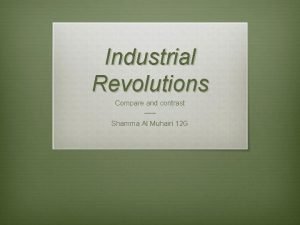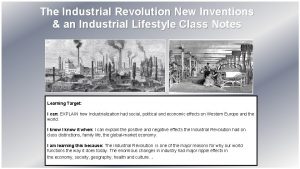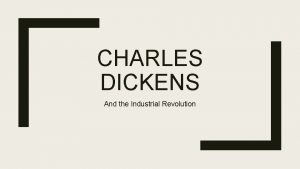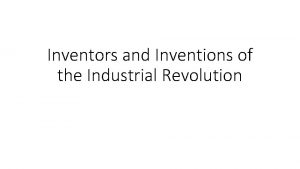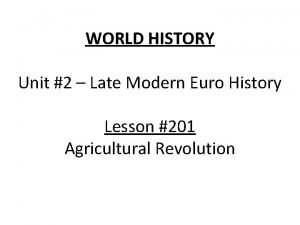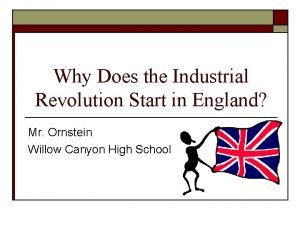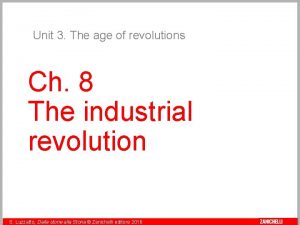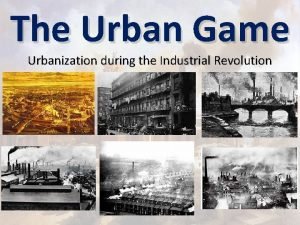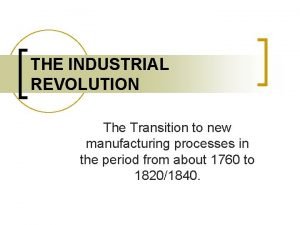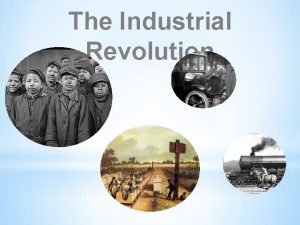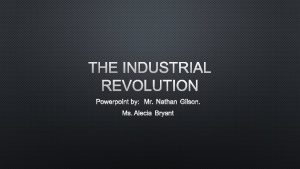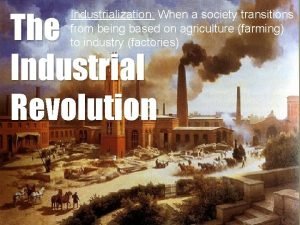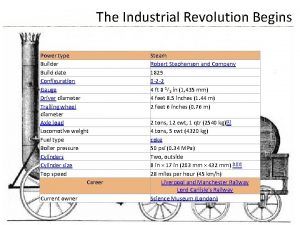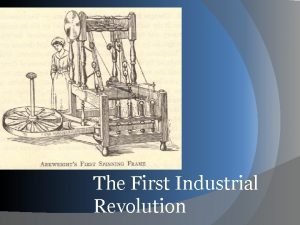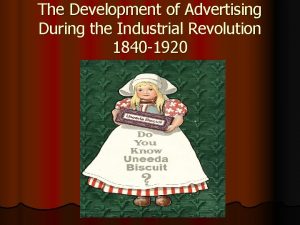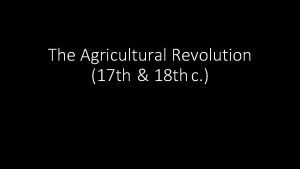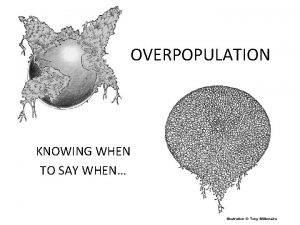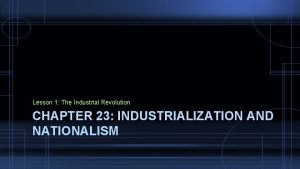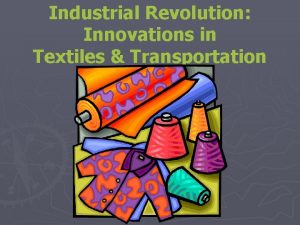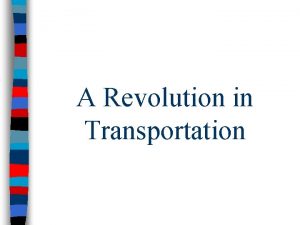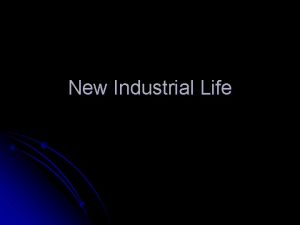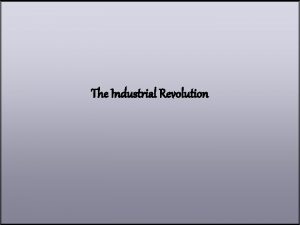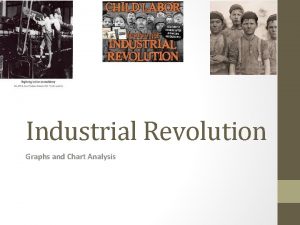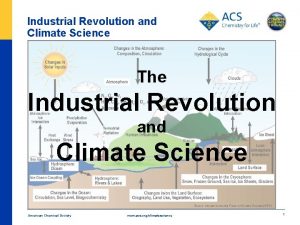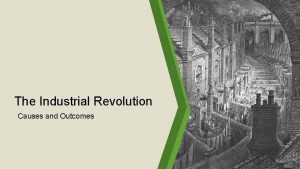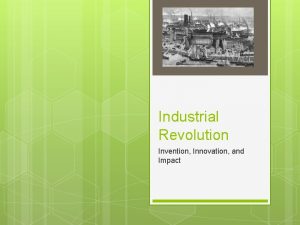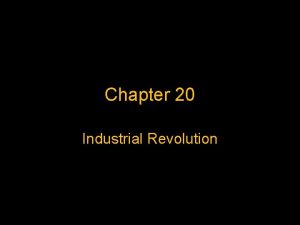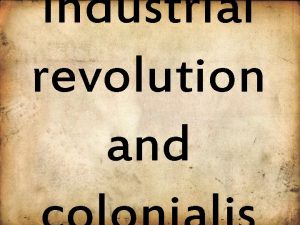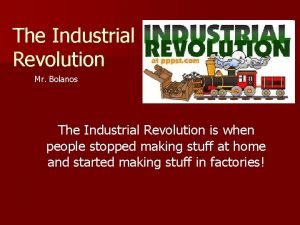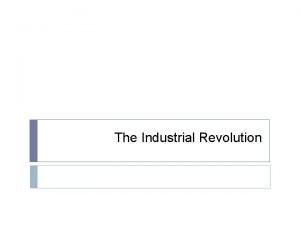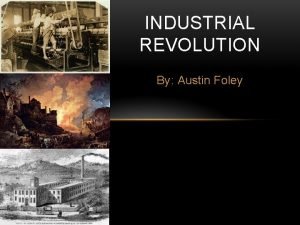Industrial Revolution Part 2 Transportation and Communication Revolution





















- Slides: 21

Industrial Revolution Part 2 – Transportation and Communication Revolution 7 th Grade History

Choo!!! Blah!!! v At the same time that the Industrial Revolution was happening, there was a revolution in transportation and communication. http: //fr. wikipedia. org/wiki/Fichier: US_Military_Railroads_engine_General_Haupt. jpg http: //www. magnet. fsu. edu/education/tutorials/museum/morsetelegraph. html

Transportation 1. Repairing Roads – at the time of Industrial Revolution, roads were not well maintained and were rutted causing coach rides to be unbearable. http: //www. history. org/history/teaching/enewsletter/april 03/travel. cfm

Transportation v Private investors began to give money to repair roads v Private roads were called turnpikes – named after medieval revolving devices with sharp pikes on them to keep people from using certain roads – private road in 18 th century had gates and guards and you had to pay a toll to use them. v 1815 – Scotsman John Mc. Adam devised using crush rock and raising the road bed so that it would drain – popular way to make roads more usable and caused trade to increase and prices to drop.

Transportation 2. Canals – British began to widen rivers and cut canals to open up trade in the late 18 th century Americans also built canals, built Erie Canal in 1825 http: //en. wikipedia. org/wiki/Erie_Canal

Transportation 3. Steam Boats – American Robert Fulton who was an inventor who is credited with creating an efficient steamboat and starting steamboat service between important cities. http: //en. wikipedia. org/wiki/Robert_Fulton http: //inventors. about. com/library/inventors/blsteamship. htm

Transportation v Steamboats were important on the Mississippi River and the Great Lakes v Steamboats carried items like lumber and passengers – some became like “floating hotels” v Early steamboats eventually resulted in ocean going steamships and by 1860 companies were offering full regular trips across the Atlantic on steamships. http: //www. gjenvick. com/Steamship. Lines/Blue. Funnel. Line/index. html#axzz 2 HDWy. Y 0 Q 5

Transportation 4. Railroads – first railway systems in the world developed in Great Britain. Could be used year round even when canals froze. http: //library. thinkquest. org/08 aug/00285/pages/railroads. html

Transportation v George Stephenson – Englishman who was called the “Father of the Railroad” who came from poverty as a child to great wealth when he died in 1848. v Influenced in his youth by http: //www. gorcc. com. au/projects/234/ wooden tramways used in coal mines to pull coal to the docks where it would be shipped out for trade – used animals to pull the cars v Stephenson developed a steam locomotive for pulling “railroad cars” in 1814

Transportation v Companies began building tramways between cities but used animals to pull the cars – instead decided to use locomotives – held a race at a place called “Rain hill” v George Stephenson’s Rocket won the race – the Rocket could pull passengers at a rate of 24 miles per hour and pull freight at a rate of 12. 5 miles per hour. http: //en. wikipedia. org/wiki/Stephenson%27 s_Rocket

Transportation v Railroads became popular in the United States due to the sheer size of the country v By 1840, there were more than 3, 000 miles of track in the eastern portion of the US v By 1860, they were discussing a railroad that would stretch to the Pacific Coast (eventually called the Transcontinental Railroad)

Transportation http: //wps. ablongman. com/long_divine_appap_7/0, 9455, 1518971 -content, 00. html

Transportation v The Northeastern portion of the US became the center of industrialization and railroads connected it to the rest of the country. v Railroads were essential in the United States Civil war for delivering troops and supplies. http: //regentsprep. org/regents/core/questions. cfm? Course=ushg&Topic. Code=1 a http: //www. alincolnlearning. us/Military_Railroad. html

Communication v The beginnings of global communication started during the Industrial Revolution time period. http: //www. allposters. co. uk/-sp/Telegraph-Lines-Running-Alongside-a-Railway-at-a-Remote. Station-in-the-Great-Plains-of-America-Posters_i 1878980_. htm

Communication v Samuel Morse – an American inventor who created an efficient telegraph and also marketed it well with his communication system called Morse Code. http: //en. wikipedia. org/wiki/Samuel_Morse http: //en. wikipedia. org/wiki/Morse_code

Communication v The word “telegraph” comes from two Greek words meaning “far” and “to write” v The telegraph allowed people to talk back and forth across continents and respond to people immediately – this was literally the first form of emails or text messages http: //ushistoryimages. com/morse-telegraph. shtm v Morse patented his telegraph in 1837

Communication v By 1861, telegraph lines stretched across the United States to the west coast v In 1866, telegraph cable was laid across the Atlantic Ocean allowing communication with Europe v By 1870, Britain had laid a telegraph cable to India – people could literally communicate worldwide! http: //www. hemp. org/news/content/transatlantic-telegraph-cable-eighth-wonder-world

Abraham Lincoln v President Abraham Lincoln, the 16 th president of the United States credited with signing the Emancipation Proclamation in 1863 to free the slaves in the South and who was assassinated by John Wilkes Booth at Ford’s Theater in Washington, D. C. in April 1865 http: //history 1800 s. about. com/od/presidentialcampaigns/ss/bestinaugurals_5. htm

The Lincoln Telegrams v President Lincoln used the telegraph to handle all types of business during the Civil War including arranging dinner meetings, suspending executions of certain people, communicating with generals and politicians throughout the country, and the release of certain prisoners of war. http: //www. dipity. com/jhsu/American-Civil-War-Innovations/

The American Civil War v Called the first modern war = 1. Factories mass produced guns, bullets, uniforms 2. Trains moved troops and equipment from battlefield to battlefield 3. Created new weapons like submarines, guns that fired more quickly, new artillery 4. Concept of “total war” – go all out to defeat the enemy – destroy crops, uproot railroads, bomb cities, destroy societies 5. Reporters and newspapers widely covered the war – telegraph allowed news to travel fast! 6. Photographs from the battles – everyday people could see what war really was like

The American Civil War v Resulted in 13 th Amendment which outlawed slavery in the US and 15 th Amendment gave black men the right to vote http: //www. loc. gov/rr/program/bib/ourdocs/13 thamendment. html
 Shamma al muhairi
Shamma al muhairi Positive effects of the industrial revolution
Positive effects of the industrial revolution Industrial revolution charles dickens
Industrial revolution charles dickens Social darwinism definition industrial revolution
Social darwinism definition industrial revolution Key inventions of the industrial revolution
Key inventions of the industrial revolution Enclosure movement
Enclosure movement Why did the industrial revolution start in britain
Why did the industrial revolution start in britain An age of revolutions zanichelli
An age of revolutions zanichelli The urban game industrial revolution
The urban game industrial revolution Enclosure movement industrial revolution
Enclosure movement industrial revolution When was the loom invented
When was the loom invented Industrial revolution transition
Industrial revolution transition Industrial revolution quiz
Industrial revolution quiz Industrial revolution powerpoint
Industrial revolution powerpoint The effects of the industrial revolution meme
The effects of the industrial revolution meme Enclosure movement definition industrial revolution
Enclosure movement definition industrial revolution Water frame significance
Water frame significance Advertising in the industrial revolution
Advertising in the industrial revolution Enclosure movement
Enclosure movement The second industrial revolution timeline
The second industrial revolution timeline Thomas malthus industrial revolution
Thomas malthus industrial revolution Lesson 1 the industrial revolution
Lesson 1 the industrial revolution
